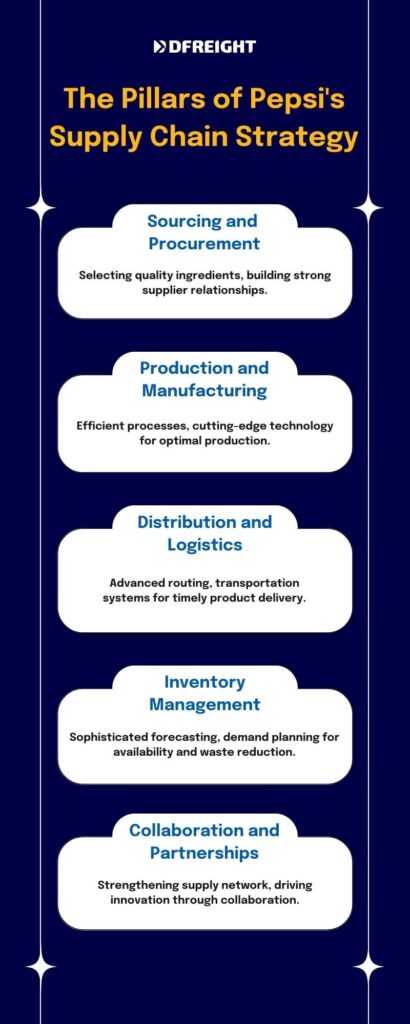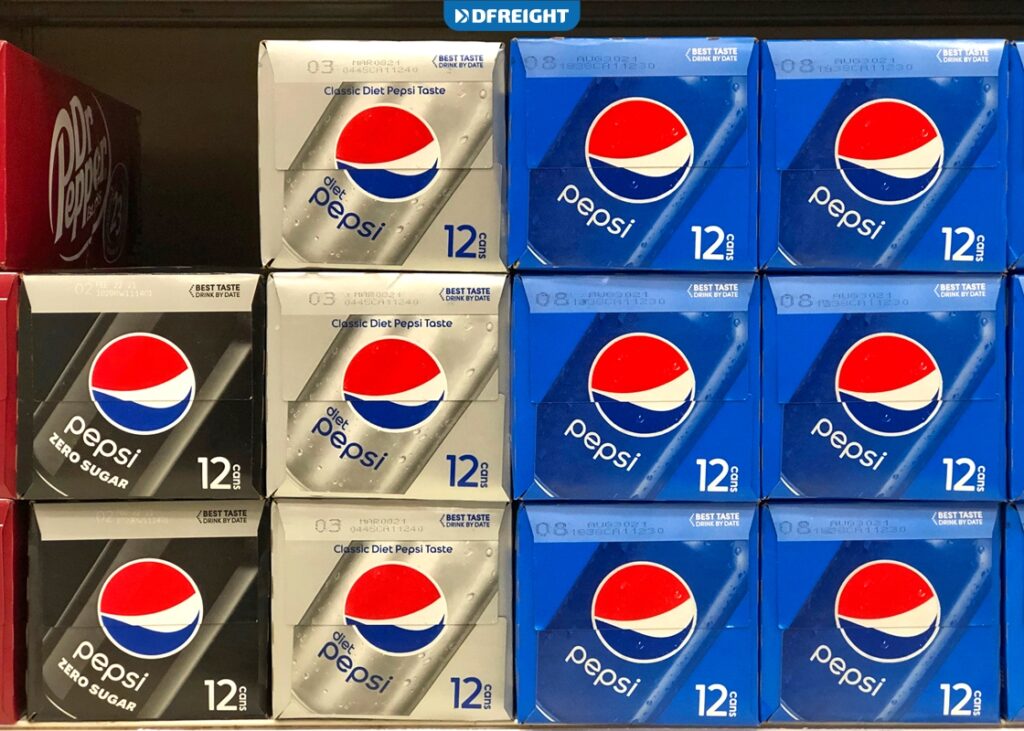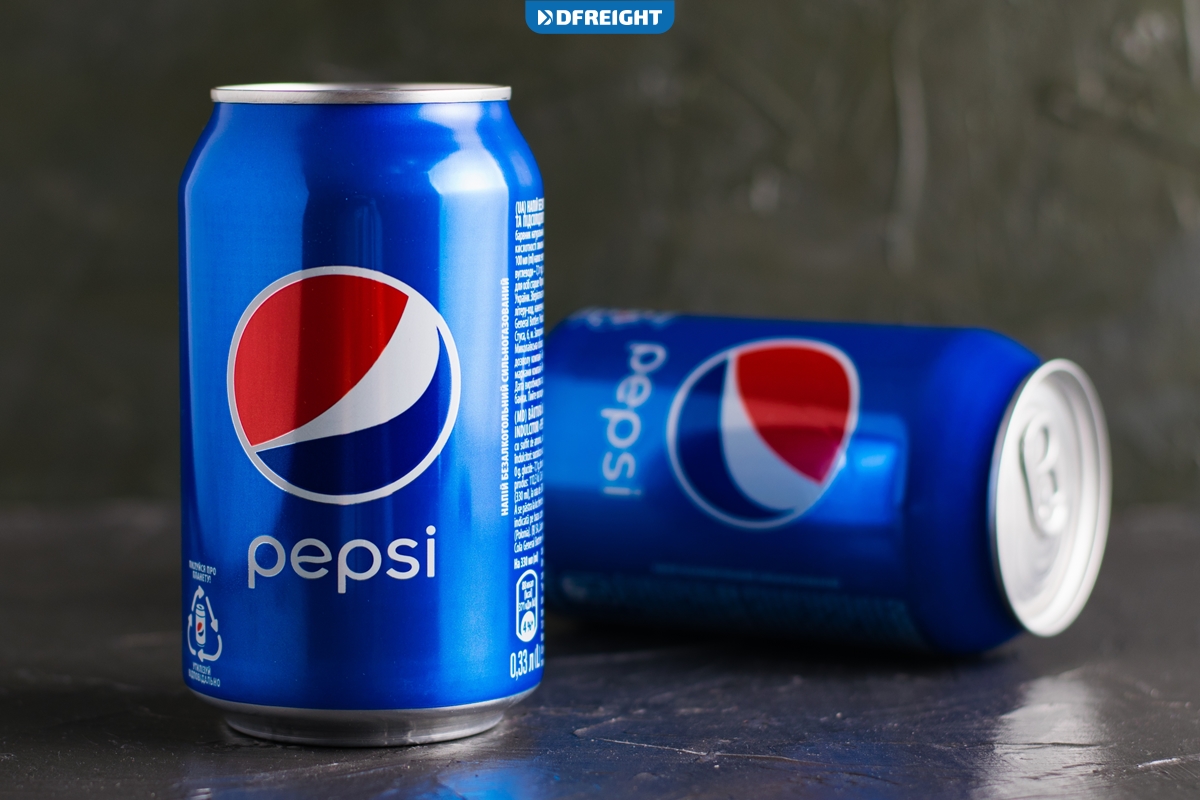In the highly competitive beverage industry, Pepsi has long been recognized as a formidable supply chain strategy leader. Behind the refreshing taste of Pepsi drinks lies a complex and efficient network that ensures timely delivery to consumers worldwide. This article delves into the inner workings of Pepsi’s supply chain strategy, shedding light on the elements that make it a powerful force in the industry.
Table of Contents
Pepsi’s Supply Chain Strategy
Pepsi, a global beverage industry leader, has built its success upon a robust and efficient supply chain strategy. By leveraging the pillars of its supply chain strategy, Pepsi ensures the availability of its products on store shelves, enhances operational efficiency, minimizes costs, and ultimately creates a competitive advantage in a rapidly evolving market. This introduction sets the stage for a closer exploration of the fundamental elements that power Pepsi’s supply chain strategy and contribute to its enduring success.
In the previous blogs, we looked into the supply chains of famous and leading companies, which you can read about each of them in the section below.
| Coca-Cola | Zara | Intel |
| Nike | Costco | Starbucks |
| Apple | Cisco | Nestlé |
| McDonald | H&M | Tesla |
| Amazon | BMW | Schneider Electric |
| Adidas | KFC | Unilever |
| Samsung | L’Oréal | IKEA |
| ADNOC | Honda | IKEA |
| Toyota | Walmart |
The Pillars of Pepsi’s Supply Chain Strategy
Pepsi’s supply chain strategy operates on multiple fronts: sourcing and procurement, production and manufacturing, distribution and logistics, inventory management, and collaboration and partnerships. Each pillar is crucial in ensuring the smooth flow of products from raw materials to store shelves.

Sourcing and Procurement
At the core of Pepsi’s supply chain strategy is sourcing and procurement. With a commitment to quality, the company carefully selects ingredients and establishes strong relationships with suppliers. This focus enables Pepsi to maintain consistency in taste and meet stringent quality standards.
Production and Manufacturing
Production and manufacturing are other key aspect of Pepsi’s supply chain prowess. The company operates global bottling plants and assembly lines, employing efficient processes and cutting-edge technology to optimize production and maximize output. By streamlining operations, Pepsi can respond to market demands swiftly while maintaining high levels of quality and efficiency.
Distribution and Logistics
The distribution and logistics segment of Pepsi’s supply chain strategy ensures that products reach their destinations in a timely and cost-effectively. Leveraging advanced routing and transportation systems, the company optimizes delivery routes, reducing lead times and minimizing costs. This enables Pepsi to stay competitive and meet customer expectations.
Inventory Management
Effective inventory management is critical to Pepsi’s success. By employing sophisticated forecasting techniques and demand planning, the company ensures the availability of its products while minimizing excess inventory. This approach helps Pepsi maintain freshness and minimize waste, thereby reducing costs and improving profitability.
Collaboration and Partnerships
Pepsi’s supply chain strategy extends beyond its operations through collaboration and partnerships. The company strengthens its supply network and fosters mutual growth by forging strong relationships with suppliers, distributors, and retailers. This collaborative approach allows Pepsi to adapt to changing market dynamics, optimize resources, and drive innovation.
Pepsi’s Use of Technology to Improve Supply Chain Efficiency
Pepsi leverages technology to enhance supply chain efficiency and drive operational excellence. Pepsi optimizes various aspects of its supply chain operations by embracing automation and data analytics. Automated systems help streamline production processes, reducing manual errors and increasing productivity. Advanced data analytics enable real-time monitoring and decision-making, allowing Pepsi to respond swiftly to changing market dynamics. Additionally, technology integration improves inventory management by enabling accurate demand forecasting and inventory tracking, minimizing stockouts, and reducing excess inventory. Overall, Pepsi’s use of technology empowers the company to optimize efficiency, enhance customer satisfaction, and stay at the forefront of the ever-evolving beverage industry.
Innovations in Pepsi’s Supply Chain Strategy
Innovations play a pivotal role in Pepsi’s supply chain strategy. Integrating technology, such as automation and data analytics, enhances operational efficiency and enables real-time decision-making. Additionally, the company strongly emphasizes sustainability, implementing eco-friendly practices like green packaging and efficient transportation to minimize its environmental impact.
Benefits of Pepsi’s Supply Chain Strategy
Pepsi’s supply chain strategy offers several key benefits that contribute to the company’s success in the beverage industry.
First and foremost, it ensures product quality and consistency by carefully sourcing and procuring high-quality ingredients. This commitment to quality allows Pepsi to deliver refreshing and consistent beverages to consumers worldwide.
Additionally, the strategy enables efficient production and manufacturing processes, optimizing output while maintaining high levels of quality and efficiency. By streamlining distribution and logistics, Pepsi can deliver products in a timely and cost-effective manner, meeting customer expectations and gaining a competitive edge.
Finally, effective inventory management techniques minimize waste and ensure product availability, resulting in improved profitability and reduced costs. Overall, Pepsi’s supply chain strategy enhances operational efficiency, supports customer satisfaction, and drives the company’s growth and success.

Challenges Faced By Pepsi’s Supply Chain Strategy
Despite its impressive supply chain strategy, Pepsi faces challenges in its pursuit of excellence. Rising raw material costs, geopolitical uncertainties, and changing consumer preferences require the company to remain agile and adaptable. By proactively addressing these challenges, Pepsi continues to enhance its supply chain operations and maintain its competitive edge.
Success Stories and Case Studies: Lessons from Pepsi’s Supply Chain Journey
Pepsi’s commitment to continuous improvement and innovation sets a benchmark for excellence in supply chain management. Numerous success stories and case studies highlight the effectiveness of Pepsi’s supply chain strategy. These experiences provide valuable insights for other industry players seeking to optimize their supply chains.
Conclusion
In conclusion, Pepsi’s supply chain strategy is a powerful engine driving the company’s success in the beverage industry. Through meticulous sourcing, streamlined production, efficient distribution, and collaborative partnerships, Pepsi ensures that its products consistently reach consumers with unrivaled freshness and quality. By embracing innovation, overcoming challenges, and remaining customer-centric, Pepsi continues to unveil the power of its supply chain strategy and shape the industry’s future.
Ready to revolutionize your supply chain management? Look no further than DFreight, the leading digital freight forwarder with an innovative online platform and user-friendly mobile app. With DFreight’s cutting-edge technology, you can streamline your logistics processes, gain real-time shipment visibility, and make data-driven decisions to optimize your supply chain. Say goodbye to manual paperwork and time-consuming processes. Take control of your supply chain with DFreight’s intuitive digital solutions. Your efficient and hassle-free logistics journey starts here! Visit our website or download our mobile app today and unlock the power of seamless supply chain management.
What are the key components of Pepsi’s supply chain strategy?
Pepsi’s supply chain strategy revolves around several key components, including ingredient sourcing, manufacturing processes, distribution networks, inventory management, and logistics. These elements work together to ensure the availability of Pepsi’s products, streamline operations, and meet customer demands.
How does Pepsi ensure the quality of its ingredients within its supply chain?
Pepsi places a strong emphasis on sourcing high-quality ingredients for its beverages. Through strategic partnerships and rigorous supplier selection processes, Pepsi works closely with farmers and suppliers to maintain strict quality standards and traceability throughout the supply chain, ensuring the integrity of its products.
How does Pepsi optimize its distribution networks to reach a global market?
Pepsi optimizes its distribution networks by strategically locating warehouses, distribution centers, and production facilities to minimize transportation costs and maximize efficiency. By leveraging advanced logistics technologies and data-driven analytics, Pepsi ensures timely delivery and efficient distribution of its products across a vast global market.
How does Pepsi manage its inventory to balance supply and demand?
Pepsi employs sophisticated inventory management techniques to strike a balance between supply and demand. By leveraging forecasting models, real-time data analysis, and collaborative planning with retailers, Pepsi optimizes its inventory levels to minimize stockouts while avoiding excessive inventory holding costs.
How does Pepsi’s supply chain strategy contribute to sustainability and environmental initiatives?
Pepsi is committed to sustainability and environmental stewardship within its supply chain. The company focuses on reducing its carbon footprint by optimizing transportation routes, adopting eco-friendly packaging solutions, and promoting responsible sourcing practices. Additionally, Pepsi actively engages in recycling and waste reduction efforts to minimize its environmental impact throughout the supply chain.














